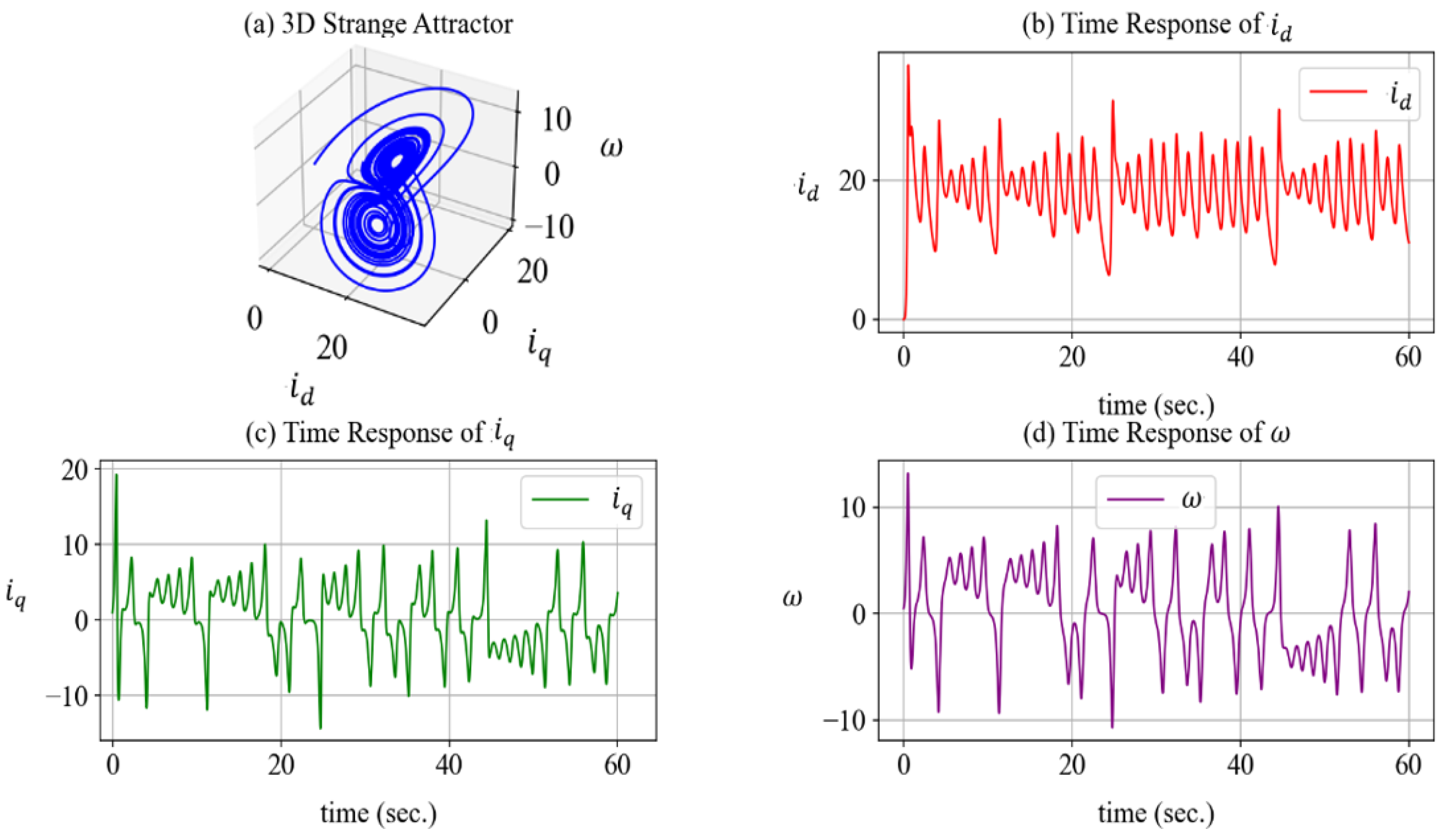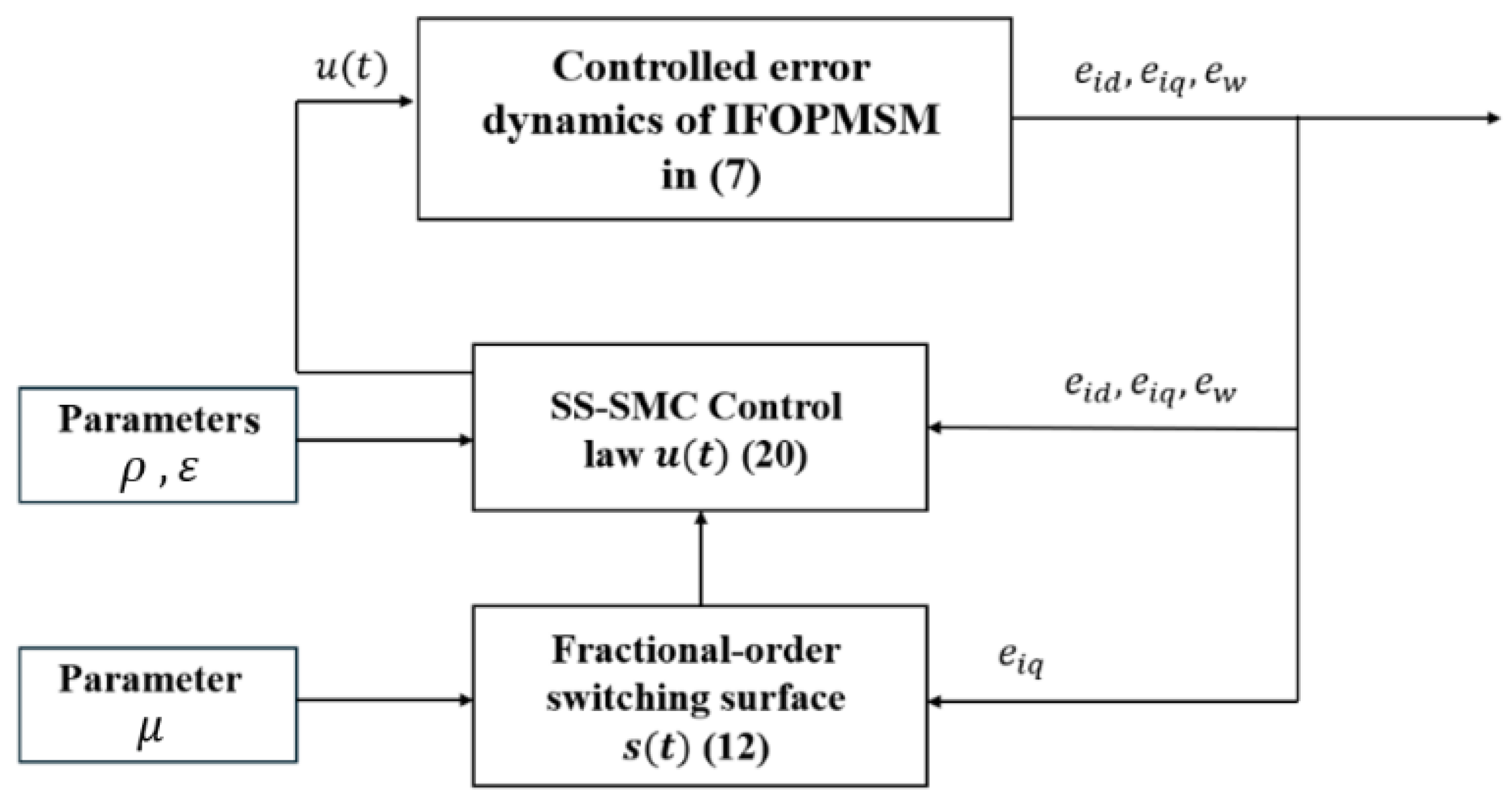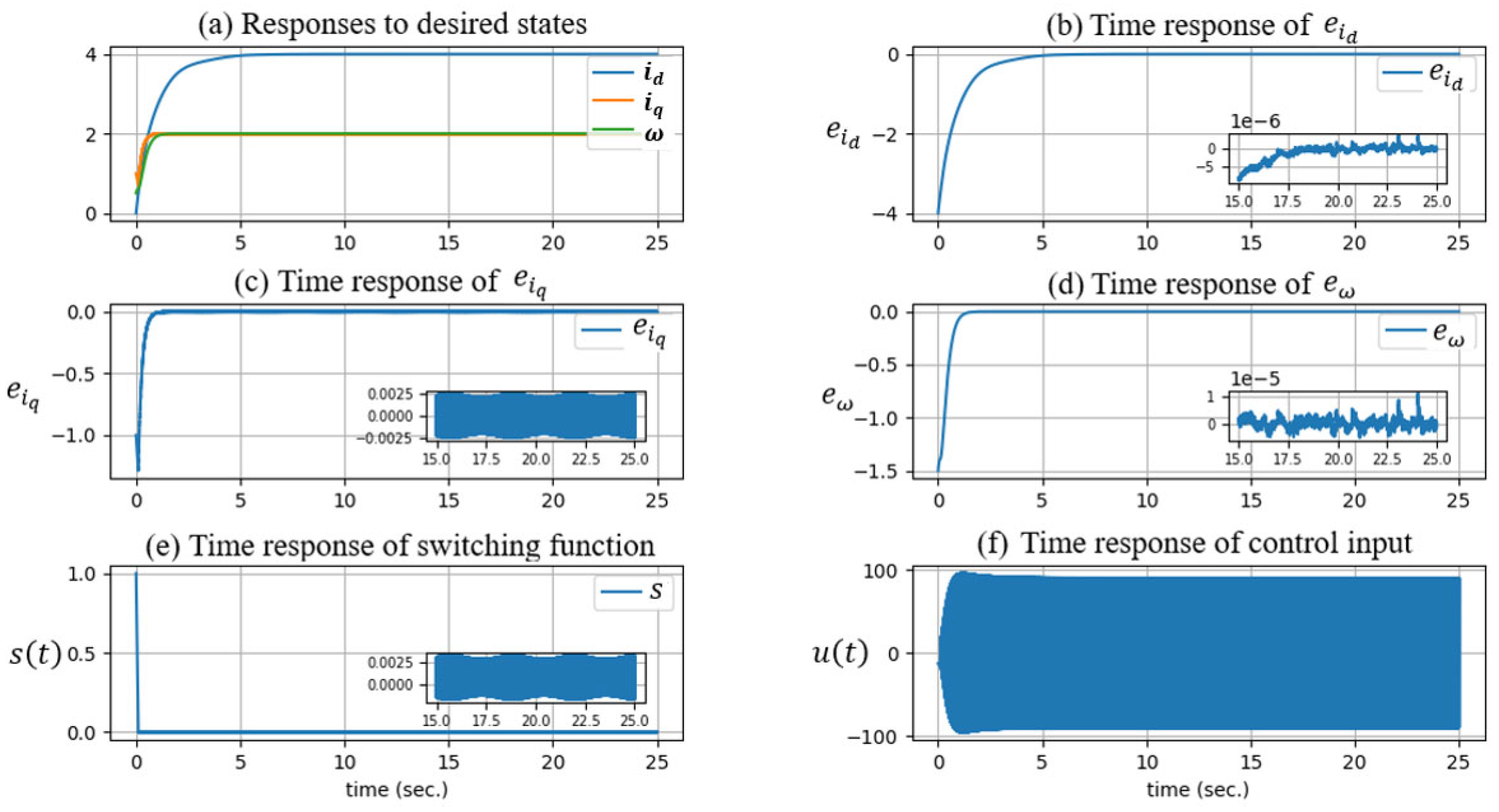Robust Angular Frequency Control of Incommensurate Fractional-Order Permanent Magnet Synchronous Motors via State-Sequential Sliding Mode Control
Abstract
1. Introduction
- Development of a novel SS-SMC strategy for chaos suppression and robust angular frequency control of IFOPMSMs under mismatched disturbances.
- Integration of a quasi-sliding mode design that replaces the discontinuous sign function with a continuous control law to eliminate chattering.
- Adoption of a state-sequential control structure that reduces the controller to a single-input design, simplifying implementation while maintaining robustness.
- Validation of both theoretical soundness and practical applicability through Lyapunov-based analysis and numerical simulations.
2. Definition and Problem Formulation
3. Fractional-Order Integral-Type Switching Surface and Error Dynamics in the Sliding Manifold
4. Numerical Experiments
5. Conclusions
Author Contributions
Funding
Institutional Review Board Statement
Informed Consent Statement
Data Availability Statement
Conflicts of Interest
References
- Zheng, W.; Luo, Y.; Chen, Y.; Pi, Y. Fractional-order modeling of permanent magnet synchronous motor speed servo system. J. Vib. Control 2015, 22, 2255–2280. [Google Scholar] [CrossRef]
- Hou, Y.Y.; Lin, A.P.; Huang, B.W.; Chen, C.-Y.; Lin, M.-H.; Saberi-Nik, H. On the dynamical behaviors in fractional-order complex PMSM system and Hamilton energy control. Nonlinear Dyn. 2024, 112, 1861–1881. [Google Scholar] [CrossRef]
- Li, X.; He, J.; Wen, C.; Liu, X.-K. Backstepping-based adaptive control of a class of uncertain incommensurate fractional-order nonlinear systems with external disturbance. IEEE Trans. Ind. Electron. 2022, 69, 4087–4095. [Google Scholar] [CrossRef]
- Roopaei, M.; Sahraei, B.R.; Lin, T.C. Adaptive sliding mode control in a novel class of chaotic systems. Commun. Nonlinear Sci. Numer. Simul. 2010, 15, 4158–4170. [Google Scholar] [CrossRef]
- Utkin, V.I. Sliding Modes in Control Optimization; Springer: Berlin/Heidelberg, Germany, 1992. [Google Scholar]
- Tang, B.; Lu, W.; Yan, B.; Lu, K.; Feng, J.; Guo, L. A novel position speed integrated sliding mode variable structure controller for position control of PMSM. IEEE Trans. Ind. Electron. 2022, 69, 12621–12631. [Google Scholar] [CrossRef]
- Carvalho, T.A.; Novaes, D.D.; Tonon, D.F. Sliding mode on tangential sets of Filippov systems. J. Nonlinear Sci. 2024, 34, 70. [Google Scholar] [CrossRef]
- Huang, C.-F.; Liao, T.-L.; Chen, C.-Y.; Yan, J.-J. The design of quasi-sliding mode control for a permanent magnet synchronous motor with unmatched uncertainties. Comput. Math. Appl. 2012, 64, 1036–1043. [Google Scholar] [CrossRef]
- Li, K.; Ding, J.; Sun, X.; Tian, X. Overview of sliding mode control technology for permanent magnet synchronous motor system. IEEE Access 2024, 12, 71685–71704. [Google Scholar] [CrossRef]
- Lin, H.; Liu, J.; Shen, X.; Leon, J.I.; Vazquez, S.; Alcaide, A.M.; Wu, L.; Franquelo, L.G. Fuzzy sliding-mode control for three-level NPC AFE rectifiers: A chattering alleviation approach. IEEE Trans. Power Electron. 2022, 37, 11704–11715. [Google Scholar] [CrossRef]
- Yim, J.; You, S.; Lee, Y.; Kim, W. Chattering attenuation disturbance observer for sliding mode control: Application to permanent magnet synchronous motors. IEEE Trans. Ind. Electron. 2023, 70, 5161–5170. [Google Scholar] [CrossRef]
- Agrawal, H.; Tiwari, P.M.; Verma, N. A chattering mitigating sliding mode control for rigid spacecraft attitude control maneuver. In Proceedings of the International Conference on Advanced Computing, Communication and Materials (ICACCM), Dehradun, India, 12–17 October 2020; pp. 12–17. [Google Scholar]
- Chi, X.; Wang, C.; Wu, Q.; Yang, J.; Lin, W.; Zeng, P.; Li, H.; Shao, M. A ripple suppression of sensorless FOC of PMSM electrical drive system based on MRAS. Results Eng. 2023, 20, 101427. [Google Scholar] [CrossRef]
- Qiu, J. Design and simulation of the fuzzy PID control system for PMSM. J. Phys. Conf. Ser. 2024, 2820, 012097. [Google Scholar] [CrossRef]
- Zhang, X.; Zhang, C.; Xu, C.; Fan, S. Multimode model predictive control for PMSM drive system. IEEE Trans. Transp. Electrif. 2023, 9, 667–677. [Google Scholar] [CrossRef]
- Wang, M.; Liu, Y.; Wang, Q.; Liao, Y.; Wheeler, P. Speed-current single-loop control of PMSM based on model-assisted cascaded extended state observer and sliding mode control. Int. J. Circuit Theory Appl. 2024, 52, 3558–3583. [Google Scholar] [CrossRef]
- Jankowska, K.; Dybkowski, M. Experimental analysis of the current sensor fault detection mechanism based on neural networks in the PMSM drive system. Electronics 2023, 12, 1170. [Google Scholar] [CrossRef]
- Zwerger, T.; Mercorelli, P. Optimal control strategies for PMSM with a decoupling super twisting SMC and inductance estimation in the presence of saturation. J. Frankl. Inst. 2024, 361, 106934. [Google Scholar] [CrossRef]
- Bian, F.; Chien, Y.-R. PMSM speed control based on improved adaptive fractional-order sliding mode control. Symmetry 2025, 17, 736. [Google Scholar] [CrossRef]
- Acosta Lúa, C.; Di Gennaro, S.; Flores Jiménez, A.B.; Guzmán, A.N. Robust Dynamic Control for Electric Vehicles with Estimation of Parametric Uncertainties and External Disturbances. IEEE Access 2024, 12, 170011–170026. [Google Scholar] [CrossRef]
- Shi, S.; Dai, L.; Min, H.; Yang, J.; Li, S. Prescribed-time nonsingular terminal sliding mode control and its application in PMSM servo systems. IEEE Trans. Ind. Electron. 2024, 72, 3072–3081. [Google Scholar] [CrossRef]
- Zaihidee, F.M.; Mekhilef, S.; Mubin, M. Application of fractional order sliding mode control for speed control of permanent magnet synchronous motor. IEEE Access 2019, 7, 101765–101774. [Google Scholar] [CrossRef]
- Anbalagan, P.; Joo, Y.H. Stabilization analysis of fractional-order nonlinear permanent magnet synchronous motor model via interval type-2 fuzzy memory-based fault-tolerant control scheme. ISA Trans. 2023, 142, 310–324. [Google Scholar] [CrossRef]
- Chen, L.; Guo, W.; Gu, P.; Lopes, A.M.; Chu, Z.; Chen, Y. Stability and stabilization of fractional-order uncertain nonlinear systems with multiorder. IEEE Trans. Circuits Syst. II Express Briefs 2023, 70, 576–580. [Google Scholar] [CrossRef]
- Chen, L.; Xue, M.; Lopes, A.M.; Wu, R.; Zhang, X.; Chen, Y. New synchronization criterion of incommensurate fractional-order chaotic systems. IEEE Trans. Circuits Syst. II Express Briefs 2024, 71, 455–459. [Google Scholar] [CrossRef]
- Li, Z.; Park, J.; Joo, Y.H.; Zhang, B.; Chen, G. Bifurcations and chaos in a permanent-magnet synchronous motor. IEEE Trans. Circuits Syst. I Fundam. Theory Appl. 2002, 49, 383–387. [Google Scholar]
- Li, C.-L.; Yu, S.-M.; Luo, X.-S. Fractional-order permanent magnet synchronous motor and its adaptive chaotic control. Chin. Phys. B 2012, 21, 100506. [Google Scholar] [CrossRef]
- Liao, T.-L.; Chang, P.-C.; Yan, J.-J. Chattering-free quasi-sliding mode control for fractional-order chaotic systems with unmatched uncertainties. Trans. Inst. Meas. Control 2025. [Google Scholar] [CrossRef]
- Jiang, Y.; Cao, D.; Chen, H. Sliding mode control for a class of variable-order fractional chaotic systems. J. Frankl. Inst. 2020, 357, 10127–10158. [Google Scholar] [CrossRef]




Disclaimer/Publisher’s Note: The statements, opinions and data contained in all publications are solely those of the individual author(s) and contributor(s) and not of MDPI and/or the editor(s). MDPI and/or the editor(s) disclaim responsibility for any injury to people or property resulting from any ideas, methods, instructions or products referred to in the content. |
© 2025 by the authors. Licensee MDPI, Basel, Switzerland. This article is an open access article distributed under the terms and conditions of the Creative Commons Attribution (CC BY) license (https://creativecommons.org/licenses/by/4.0/).
Share and Cite
Hu, G.-H.; Ho, C.-W.; Yan, J.-J. Robust Angular Frequency Control of Incommensurate Fractional-Order Permanent Magnet Synchronous Motors via State-Sequential Sliding Mode Control. Mathematics 2025, 13, 2669. https://doi.org/10.3390/math13162669
Hu G-H, Ho C-W, Yan J-J. Robust Angular Frequency Control of Incommensurate Fractional-Order Permanent Magnet Synchronous Motors via State-Sequential Sliding Mode Control. Mathematics. 2025; 13(16):2669. https://doi.org/10.3390/math13162669
Chicago/Turabian StyleHu, Guo-Hsin, Chia-Wei Ho, and Jun-Juh Yan. 2025. "Robust Angular Frequency Control of Incommensurate Fractional-Order Permanent Magnet Synchronous Motors via State-Sequential Sliding Mode Control" Mathematics 13, no. 16: 2669. https://doi.org/10.3390/math13162669
APA StyleHu, G.-H., Ho, C.-W., & Yan, J.-J. (2025). Robust Angular Frequency Control of Incommensurate Fractional-Order Permanent Magnet Synchronous Motors via State-Sequential Sliding Mode Control. Mathematics, 13(16), 2669. https://doi.org/10.3390/math13162669






